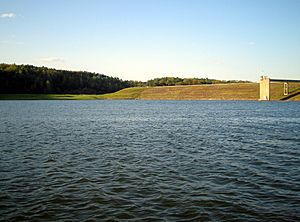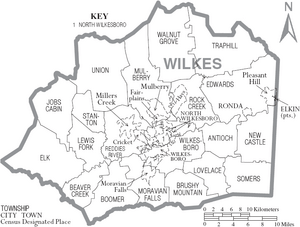Wilkes County, North Carolina facts for kids
Quick facts for kids
Wilkes County
|
||
|---|---|---|
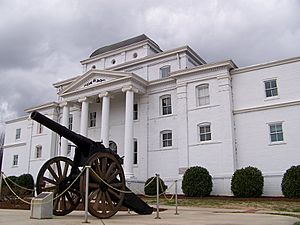
Old Wilkes County Courthouse
|
||
|
||
| Motto(s): | ||
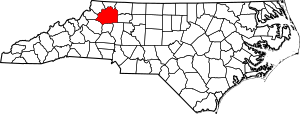
Location within the U.S. state of North Carolina
|
||
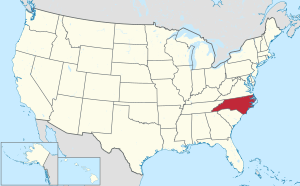 North Carolina's location within the U.S. |
||
| Country | ||
| State | ||
| Founded | April 20, 1778 | |
| Named for | John Wilkes | |
| Seat | Wilkesboro | |
| Largest community | North Wilkesboro | |
| Area | ||
| • Total | 756.33 sq mi (1,958.9 km2) | |
| • Land | 753.68 sq mi (1,952.0 km2) | |
| • Water | 2.65 sq mi (6.9 km2) 0.35% | |
| Population
(2020)
|
||
| • Total | 65,969 | |
| • Estimate
(2023)
|
66,013 |
|
| • Density | 86.38/sq mi (33.35/km2) | |
| Time zone | UTC−5 (Eastern) | |
| • Summer (DST) | UTC−4 (EDT) | |
| Congressional district | 5th | |
Wilkes County is a county located in the western U.S. state of North Carolina. It is known for its beautiful mountain scenery. In 2020, the county had a population of 65,969 people. The main town and county seat is Wilkesboro. The biggest community is North Wilkesboro. Wilkes County is part of the North Wilkesboro Micropolitan Statistical Area.
Contents
History of Wilkes County
Wilkes County was created on April 20, 1778. It was formed from parts of Surry County and Washington District. The county was named after John Wilkes, an English politician. He supported the American colonists during the American Revolution.
Over the years, parts of Wilkes County were used to form other counties. These include Ashe County (1799), Caldwell County (1841), Alexander County (1847), and Watauga County (1849). This shows how the county's shape changed over time.
Fast Cars and Racing: The Birth of NASCAR
Wilkes County has a unique history with fast cars. In the past, some people in the county made special homemade drinks. They would deliver these drinks to towns and cities. To avoid being caught, they often had to drive very fast. This need for speed helped create the sport of stock-car racing.
The North Wilkesboro Speedway was one of the first places where NASCAR races happened. NASCAR stands for the National Association of Stock Car Auto Racing. The first race there was on May 18, 1947. The first official NASCAR race was on October 16, 1949.
Many famous NASCAR drivers came from Wilkes County. Junior Johnson was a legendary driver and also known for his fast driving skills. He became a national hero after a famous article was written about him. His story was even made into a movie called The Last American Hero (1973). Other notable NASCAR drivers from Wilkes include Benny Parsons and Jimmy Pardue.
The North Wilkesboro Speedway closed after the 1996 NASCAR season. Its races were moved to other tracks. However, there was a big effort to bring racing back. In November 2021, the state of North Carolina gave $18 million for renovations. After these repairs, the Speedway held races again in August 2022. It drew a huge crowd. In September 2022, it was announced that the 2023 NASCAR All-Star Race would be held there. This was the first NASCAR race at the track since 1996. Kyle Larson won the All-Star race on May 21, 2023. He also won the NASCAR Craftsman Truck Series race on May 20, 2023. The NASCAR All-Star race was also held at the Speedway in May 2024 and May 2025.
Geography of Wilkes County
Wilkes County covers about 756 square miles. Most of this area is land, with a small part being water.
The county is located on the eastern side of the Blue Ridge Mountains. These mountains are part of the larger Appalachian Mountains. The land in Wilkes County changes a lot. It goes from about 900 feet high in the east to over 4,000 feet high in the west. The Blue Ridge Parkway is a scenic road that runs along the mountains on the county's northern and western edges.
Stone Mountain State Park is in northern Wilkes County. It is a very popular state park. People enjoy rock climbing and trout fishing there. The Brushy Mountains form the county's southern border. As you move east, the land becomes flatter. The Yadkin River flows through the middle of the county. Other important rivers include the Reddies River, Roaring River, and Mulberry Creek.
After big floods in 1916 and 1940, the W. Kerr Scott Dam and Reservoir was built on the Yadkin River. It opened in 1962. This dam created a large lake with 56 miles of shoreline. The lake is great for boating, swimming, fishing, and waterskiing. It is especially known for its excellent bass fishing. This lake is the largest body of water in Wilkes County.
Weather in Wilkes County
Wilkes County has different types of weather because of its varying elevations. In winter, it can be sunny in the east while snowing in the mountains. The county gets a good amount of rain. Thunderstorms are common in spring and summer. In winter, you might see rain, snow, or freezing rain. Wilkesboro, the main town, gets about 50 inches of rain and 10 inches of snow each year.
Strong storms are not common, but they do happen. Sometimes, strong winds can knock down trees and power lines. Wilkes County can also experience flash floods because of its many creeks and streams. The W. Kerr Scott Dam helps control flooding on the Yadkin River.
Natural Areas to Explore
- Blue Ridge Parkway (part)
- Doughton Recreation Area (part)
- E.B. Jeffress Park
State and Local Parks
- Buffalo Cove Game Land (part)
- Kerr Scott Game Land
- Rendezvous Mountain State Forest Game Land
- Rendezvous Mountain State Park
- Stone Mountain State Park (part)
- Thurmond Chatham Game Land (part)
Major Water Bodies
- Big Sandy Creek
- Big Warrior Creek
- Brier Creek
- Coal Creek
- Cub Creek
- Dugger Creek
- East Prong Roaring River
- Elk Creek
- Elkin Creek
- Fall Creek
- Fishing Creek
- Grassy Fork
- Hunting Creek
- Little Dugger Creek
- Little Elkin Creek
- Little Hunting Creek
- Lousy Creek
- Mulberry Creek
- Osborn Creek
- North Fork Reddies River
- North Little Hunting Creek
- Reddies River
- Roaring River
- Sandy Creek
- South Fork Reddies River
- W. Kerr Scott Dam and Reservoir
- Yadkin River
- Yates Creek
Neighboring Counties
- Alexander County – south
- Alleghany County – north
- Ashe County – northwest
- Caldwell County – southwest
- Iredell County – southeast
- Surry County – northeast
- Watauga County – west
- Yadkin County – east
Main Roads and Transportation
 US 21
US 21 US 421
US 421


 US 421 Bus.
US 421 Bus. NC 16
NC 16 NC 18
NC 18 NC 115
NC 115 NC 268
NC 268 NC 268A (alternative route)
NC 268A (alternative route)
 NC 268 Bus.
NC 268 Bus.
Wilkes County has several state and U.S. highways. It also has an airport and public transportation. The Blue Ridge Parkway runs through Wilkes, offering beautiful scenic drives.
Important Places and Services
- North Wilkesboro Speedway, a famous racing track
- Wilkes County Airport
- Wilkes Transportation Authority, which provides bus and van services
People of Wilkes County
| Historical population | |||
|---|---|---|---|
| Census | Pop. | %± | |
| 1790 | 8,157 | — | |
| 1800 | 7,247 | −11.2% | |
| 1810 | 9,054 | 24.9% | |
| 1820 | 9,967 | 10.1% | |
| 1830 | 11,968 | 20.1% | |
| 1840 | 12,577 | 5.1% | |
| 1850 | 12,099 | −3.8% | |
| 1860 | 14,749 | 21.9% | |
| 1870 | 15,539 | 5.4% | |
| 1880 | 19,181 | 23.4% | |
| 1890 | 22,675 | 18.2% | |
| 1900 | 26,872 | 18.5% | |
| 1910 | 30,282 | 12.7% | |
| 1920 | 32,644 | 7.8% | |
| 1930 | 36,162 | 10.8% | |
| 1940 | 43,003 | 18.9% | |
| 1950 | 45,243 | 5.2% | |
| 1960 | 45,269 | 0.1% | |
| 1970 | 49,524 | 9.4% | |
| 1980 | 58,657 | 18.4% | |
| 1990 | 59,393 | 1.3% | |
| 2000 | 65,352 | 10.0% | |
| 2010 | 69,340 | 6.1% | |
| 2020 | 65,969 | −4.9% | |
| 2023 (est.) | 66,013 | −4.8% | |
| U.S. Decennial Census 1790–1960 1900–1990 1990–2000 2010 2020 |
|||
2020 Census Information
| Group | Number | Percentage |
|---|---|---|
| White (not Hispanic) | 56,316 | 85.37% |
| Black or African American (not Hispanic) | 2,580 | 3.91% |
| Native American | 86 | 0.13% |
| Asian | 324 | 0.49% |
| Pacific Islander | 5 | 0.01% |
| Other/Mixed | 2,004 | 3.04% |
| Hispanic or Latino | 4,654 | 7.05% |
According to the 2020 census, there were 65,969 people living in Wilkes County. There were 28,376 households and 17,409 families.
Religion in Wilkes County
Most people in Wilkes County are Protestant Christians. The main church group is the Baptists. There are also many Methodist, Presbyterian, and Episcopalian churches. In recent years, more Roman Catholics have moved to Wilkes County. There is one Catholic church in North Wilkesboro.
Government and Politics
PresRow|1936|Republican|8,358|6,506|0|North Carolina}}
| Year | Republican | Democratic | Third party | |||
|---|---|---|---|---|---|---|
| No. | % | No. | % | No. | % | |
| 2024 | 28,812 | 79.33% | 7,194 | 19.81% | 314 | 0.86% |
| 2020 | 27,592 | 77.80% | 7,511 | 21.18% | 363 | 1.02% |
| 2016 | 23,752 | 75.89% | 6,638 | 21.21% | 906 | 2.89% |
| 2012 | 20,515 | 70.39% | 8,148 | 27.96% | 482 | 1.65% |
| 2008 | 20,288 | 68.25% | 8,934 | 30.06% | 502 | 1.69% |
| 2004 | 19,197 | 70.70% | 7,862 | 28.95% | 95 | 0.35% |
| 2000 | 16,826 | 69.18% | 7,226 | 29.71% | 271 | 1.11% |
| 1996 | 12,395 | 58.39% | 6,793 | 32.00% | 2,040 | 9.61% |
| 1992 | 12,547 | 52.57% | 7,991 | 33.48% | 3,330 | 13.95% |
| 1988 | 15,231 | 67.65% | 7,230 | 32.11% | 53 | 0.24% |
| 1984 | 18,670 | 73.03% | 6,852 | 26.80% | 42 | 0.16% |
| 1980 | 14,462 | 62.74% | 8,184 | 35.51% | 403 | 1.75% |
| 1976 | 11,768 | 53.43% | 10,176 | 46.20% | 80 | 0.36% |
| 1972 | 13,015 | 72.69% | 4,634 | 25.88% | 255 | 1.42% |
| 1968 | 11,195 | 60.29% | 4,497 | 24.22% | 2,876 | 15.49% |
| 1964 | 11,014 | 54.55% | 9,176 | 45.45% | 0 | 0.00% |
| 1960 | 13,016 | 61.98% | 7,986 | 38.02% | 0 | 0.00% |
| 1956 | 11,544 | 66.29% | 5,870 | 33.71% | 0 | 0.00% |
| 1952 | 11,446 | 61.57% | 7,143 | 38.43% | 0 | 0.00% |
| 1948 | 8,234 | 57.18% | 5,784 | 40.17% | 382 | 2.65% |
| 1944 | 9,121 | 62.01% | 5,587 | 37.99% | 0 | 0.00% |
| 1940 | 8,446 | 53.64% | 7,299 | 46.36% | 0 | 0.00% |
| 1932 | 6,522 | 53.64% | 5,598 | 46.04% | 39 | 0.32% |
| 1928 | 7,808 | 73.59% | 2,802 | 26.41% | 0 | 0.00% |
| 1924 | 6,131 | 63.02% | 3,586 | 36.86% | 11 | 0.11% |
| 1920 | 6,451 | 69.41% | 2,843 | 30.59% | 0 | 0.00% |
| 1916 | 3,470 | 68.01% | 1,632 | 31.99% | 0 | 0.00% |
| 1912 | 331 | 7.29% | 1,636 | 36.05% | 2,571 | 56.65% |
| 1908 | 3,382 | 68.34% | 1,559 | 31.50% | 8 | 0.16% |
| 1904 | 2,470 | 65.21% | 1,318 | 34.79% | 0 | 0.00% |
| 1900 | 2,840 | 62.47% | 1,704 | 37.48% | 2 | 0.04% |
| 1896 | 2,835 | 61.07% | 1,801 | 38.80% | 6 | 0.13% |
| 1892 | 1,895 | 49.74% | 1,770 | 46.46% | 145 | 3.81% |
| 1888 | 2,292 | 57.31% | 1,691 | 42.29% | 16 | 0.40% |
| 1884 | 2,028 | 60.20% | 1,341 | 39.80% | 0 | 0.00% |
| 1880 | 1,583 | 51.18% | 1,510 | 48.82% | 0 | 0.00% |
Wilkes County has mostly voted for the Republican Party since the American Civil War. This is partly because many people in the county supported the Union during the war. The county's government is run by a board of commissioners and a county manager. As of 2024, the chairman of the commissioners is Casey Joe Johnson.
Wilkes County is part of the High Country Council of Governments. This group helps different local governments work together.
Economy and Jobs
Wilkes County is a rural area, but it has been the starting place for many big companies. Lowe's, a large home-improvement store chain, started in Wilkes County in 1946. Even though Lowe's moved its main offices, it still has a big office in Wilkesboro. It is the county's second-largest employer. Carolina West Wireless, a phone company, also started and is based in Wilkesboro.
Other businesses that began here include Lowes Foods and The Northwestern Bank. The Carolina Mirror Company was once the biggest mirror factory in America. Today, Gardner Glass Products Inc. still makes mirrors in North Wilkesboro. Holly Farms, a large chicken producer, was bought by Tyson Foods. Wilkes County is still a major producer of poultry. Tyson Foods is now the largest employer in the county.
Like many rural areas, Wilkes County has seen changes in its economy. Many textile and furniture factories have closed. This has led to fewer manufacturing jobs. However, the county's economy has been improving in recent years.
Wine Production in Wilkes County
Wilkes County is part of the Yadkin Valley AVA. This is a special area known for growing grapes and making wine. As tobacco farming has decreased, some farmers in Wilkes County have started growing grapes for wine. They even get help from experts from Europe and California. Wine-making is becoming more popular in Wilkes and nearby counties.
Every May, Wilkes County celebrates its wine industry with the Shine to Wine Festival. This festival is held in downtown North Wilkesboro. It celebrates the county's history and its growing wine industry.
Education in Wilkes County
The Wilkes County Schools system has 22 schools. These schools serve students from pre-kindergarten to twelfth grade. There are 5 high schools, 4 middle schools, and 13 elementary schools. Bridges Charter School is the only charter school in the county. Some parts of Wilkes are also served by the Elkin City Schools district.
Wilkes County has three private schools, all connected to Protestant Christian churches. The biggest private school is Millers Creek Christian School. More students are also being home schooled in recent years. The only college in Wilkes County is Wilkes Community College (WCC). It is a public two-year college.
The Appalachian Regional Library serves Wilkes County.
Media and News
Wilkes County has two local newspapers:
- Wilkes Journal-Patriot – This paper was founded in 1906 and is published once a week.
- The Record of Wilkes – This newspaper is published online once a week. It often focuses on local arts and culture.
The county also has three radio stations:
- WKBC-FM (97.3 FM) – Plays adult contemporary music and broadcasts sports from Appalachian State University.
- WKBC (AM) (800 AM) – Plays American country music.
- WWWC (AM) (1240 AM & 100.1 FM) – Plays Southern Gospel music and shares local news and high school sports.
Most people in the county can also watch TV stations from Winston-Salem.
GoWilkes.com is an online media source for Wilkes County. It allows residents to talk about local events. It was named the 2004 Small Business of the Year.
Hospitals and Healthcare
Wilkes Medical Center opened in 1952. In 2017, Wake Forest Baptist Health took over the hospital. It is now the largest hospital in northwestern North Carolina. It is also Wilkes County's fourth-largest employer. West Park, which used to be a shopping center, is now a large medical park. It has many offices for doctors, specialists, and other health services.
Events and Festivals
Wilkes County has a rich musical history. This is celebrated at several events:
The Shine to Wine Festival is held in downtown North Wilkesboro every May. It celebrates the county's journey from its past to its growing wine industry.
The annual Brushy Mountain Apple Festival is held in downtown North Wilkesboro. It takes place on the first weekend in October. This festival attracts over 160,000 visitors each year. It is one of the biggest arts and crafts fairs in the Southern United States.
Carolina in the Fall is another music festival. It happens every September in Historic Downtown Wilkesboro. It features music, a wine and beer garden, and a food truck competition.
The Carolina West Wireless Community Commons and Wilkes Communications Pavilion hosts "Concerts on the Commons." This is a live music series from May to October.
MerleFest is a very famous music festival. It was started in 1988 by legendary guitarist Doc Watson and Bill Young. The festival is named after Doc's son, Merle Watson. It is held at Wilkes Community College. MerleFest is one of the largest folk and bluegrass music festivals in the United States. It brings in over 75,000 music fans each year. The festival helps raise money for the college. It also brings over $10 million in business and tourism money to Wilkes County.
Communities in Wilkes County
Towns
- Elkin (also in Surry County)
- North Wilkesboro (largest community)
- Ronda
- Wilkesboro (county seat)
Census-Designated Places
Other Communities
Townships
- Antioch
- Beaver Creek
- Boomer
- Brushy Mountains
- Edwards
- Elk
- Jobs Cabin
- Lewis Fork
- Lovelace
- Moravian Falls
- Mulberry
- New Castle
- North Wilkesboro
- Rock Creek
- Reddies River
- Somers
- Stanton
- Traphill
- Union
- Walnut Grove
- Wilkesboro
Famous People from Wilkes County
- Bobby Billings (born 1975), musician and songwriter
- Rhoda Bryan Billings (1937), law professor and former Chief Justice of the North Carolina Supreme Court
- Daniel Boone (1734–1820), famous explorer and pioneer
- John Brown (1738–1812), a captain during the American Revolutionary War
- Chang and Eng Bunker (1811–1874), famous Siamese twins who settled in Wilkes County
- Robert Byrd (1917–2010), a U.S. Senator from West Virginia for many years
- Lady Sarah Lou Harris Carter (1923-2019), a pioneering African-American model and humanitarian
- Benjamin Cleveland (1738–1806), a colonel in the North Carolina militia during the American Revolutionary War
- Dean Combs (1952), former NASCAR driver
- Jeffrey Elmore (1978), a North Carolina politician
- Zach Galifianakis (born 1969), actor and comedian
- James B. Gordon (1822–1864), a general in the Confederate Army
- Deneen Graham (born 1964), the first black woman to be crowned Miss North Carolina
- Jim Hamby (1897-1991), former MLB player
- Roger Hamby (born 1943), former NASCAR driver and team owner
- Junior Johnson (1931–2019), a legendary NASCAR racer and car owner
- Sallie Chapman Gordon Law (1805–1894), the first recorded Confederate nurse in the Civil War
- William Ballard Lenoir (1751–1839), the first President of the University of North Carolina at Chapel Hill
- Jimmy Pardue (1930-1964), former NASCAR driver
- Benny Parsons (1941–2007), NASCAR champion and TV racing analyst
- James Larkin Pearson (1879–1981), poet and newspaper publisher
- Shirley Randleman (1950), a North Carolina State Representative and Senator
- Waylon Reavis (born 1978), musician, lead singer of the band Mushroomhead
- Shirrel Rhoades (born 1942), writer, publisher, and former executive at Marvel Entertainment
- Eddie Settle, a member of the North Carolina Senate
- Morgan Shepherd (born 1941), a NASCAR driver for over fifty years
- Montford Stokes (1762–1842), a United States Senator and Governor of North Carolina
- John Swofford (born 1948), former Commissioner of the Atlantic Coast Conference (ACC)
- William Oliver Swofford (1945–2000), a pop singer known as Oliver
The Story of Tom Dooley
Tom Dula (Dooley) was from Wilkes County. He was a soldier who returned home after the American Civil War. His story became a famous folk legend. Many people believe he was wrongly blamed for a crime. His story was made popular by the hit song "Hang Down Your Head, Tom Dooley" by the Kingston Trio in 1958. There was also a movie about him in 1959. Each summer, a play based on his story is performed outdoors. In 2001, Tom Dula was officially cleared of all charges by the county.
See also
 In Spanish: Condado de Wilkes (Carolina del Norte) para niños
In Spanish: Condado de Wilkes (Carolina del Norte) para niños
- List of counties in North Carolina
- National Register of Historic Places listings in Wilkes County, North Carolina
- Swan Creek AVA, a wine region partly in the county
- Yadkin Valley AVA, a wine region partly in the county



